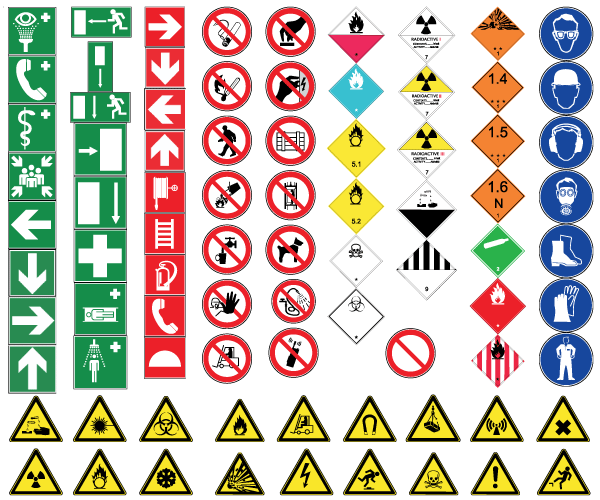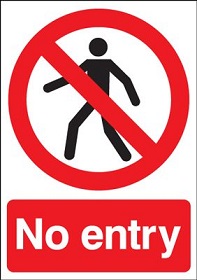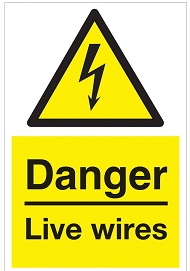Safety signs
Contents |
[edit] Introduction
The requirement for safety signs was mandated by the Health and safety at work etc act 1974. This was further enforced by the Health and Safety (Safety Signs and Signals) Regulations 1996.
The regulations require that safety signs are provided and maintained in circumstances where a health and safety risk is present that other methods have not been employed to remove or control. The primary aim of such signage is to further reduce risks presented by the hazards.
Signs convey information or instructions through a combination of shape, colour, and symbol (pictogram). Supplementary text can also be provided, such as ‘Fire exit’. Signs can be illuminated by using transparent or translucent materials lit from behind.
A number of different types of safety sign are described below.
[edit] Prohibition signs
Prohibition signs prohibit action which is likely to increase or cause danger, such as ‘No entry’. They are characterised by a round shape, and can either be a black pictogram on a white background, or can have red edging and a diagonal line.
[edit] Warning signs
Warning signs warn of a hazard or danger, such as ‘Danger: Toxic materials’. They are characterised by a triangular shape, and usually feature a black pictogram on a yellow background with black edging.
[edit] Mandatory signs
Mandatory signs prescribe specific behaviour, such as ‘Eye protection must be worn’. They are characterised by a round shape, and usually feature a white pictogram on a blue background.
[edit] Emergency escape or first-aid signs
Emergency escape and first-aid signs provide information on emergency exits, first aid or rescue facilities, such as ‘Emergency exit’. They are characterised by a rectangular or square shape, and usually feature a white pictogram on a green background.
They must be well maintained, and able to function during a power failure. The light from illuminated signs should be bright enough to be seen without causing glare.
[edit] Fire safety sign
A fire safety sign is defined as a sign which provides:
- Warning in case of fire.
- Information on escape routes and emergency exits (coloured green).
- Information on the identification or location of firefighting equipment (coloured red).
Fire exit signs should be displayed immediately above or near to the exit opening, where it is least likely to be obscured or obstructed by smoke. Buildings that have multiple occupants should adopt a common approach to the provision of fire safety signs, to avoid confusion about exit routes.
[edit] Related articles on Designing Buildings Wiki
Featured articles and news
One of the most impressive Victorian architects. Book review.
RTPI leader to become new CIOB Chief Executive Officer
Dr Victoria Hills MRTPI, FICE to take over after Caroline Gumble’s departure.
Social and affordable housing, a long term plan for delivery
The “Delivering a Decade of Renewal for Social and Affordable Housing” strategy sets out future path.
A change to adoptive architecture
Effects of global weather warming on architectural detailing, material choice and human interaction.
The proposed publicly owned and backed subsidiary of Homes England, to facilitate new homes.
How big is the problem and what can we do to mitigate the effects?
Overheating guidance and tools for building designers
A number of cool guides to help with the heat.
The UK's Modern Industrial Strategy: A 10 year plan
Previous consultation criticism, current key elements and general support with some persisting reservations.
Building Safety Regulator reforms
New roles, new staff and a new fast track service pave the way for a single construction regulator.
Architectural Technologist CPDs and Communications
CIAT CPD… and how you can do it!
Cooling centres and cool spaces
Managing extreme heat in cities by directing the public to places for heat stress relief and water sources.
Winter gardens: A brief history and warm variations
Extending the season with glass in different forms and terms.
Restoring Great Yarmouth's Winter Gardens
Transforming one of the least sustainable constructions imaginable.
Construction Skills Mission Board launch sector drive
Newly formed government and industry collaboration set strategy for recruiting an additional 100,000 construction workers a year.
New Architects Code comes into effect in September 2025
ARB Architects Code of Conduct and Practice available with ongoing consultation regarding guidance.
Welsh Skills Body (Medr) launches ambitious plan
The new skills body brings together funding and regulation of tertiary education and research for the devolved nation.
Paul Gandy FCIOB announced as next CIOB President
Former Tilbury Douglas CEO takes helm.



























